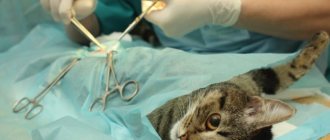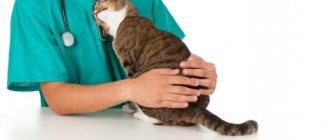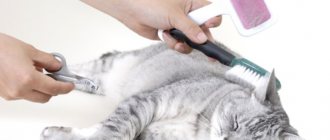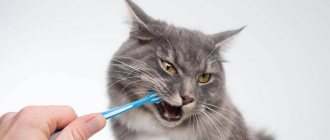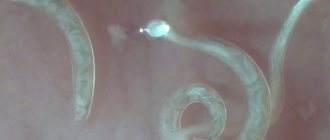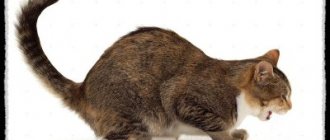5327Pavel
1
Experts have identified a large number of bone and paw diseases in cats, some of which appear in animals much more often than others. Some paw diseases in cats make themselves known early and can go away instantly if treatment is started on time. In case of hopeless forms, it is recommended to seek help from a specialist as soon as possible so that the veterinarian can prescribe competent treatment.
The most popular problems in cats and cats are:
- breaking, cracking and ingrown claws
- damage, cracks and foreign objects in the paw pads
© shutterstock
Problems must be eliminated, so the cat will feel out of danger, feel comfort and care from the owners, and will trust the person more.
Ingrown claws in cats
Cats need to scratch non-stop to keep their claws sharp and clean. When members of the cat family are unable to sharpen their claws, health problems occur. For pets, you need to install a scratching post at home so that cats can have the opportunity to stretch their claws without any problems.
Ingrowth occurs more often in cats that are not very active. Therefore, the owner needs to monitor the condition of the animal’s claws and maintain them in a normal form - trim off the excess so that the paw pads do not grow into the soft tissues. Because of this, the paw will hurt, and inflammation and even a purulent process may begin in the claw area due to the accumulation of dirt in this place. In this case, the veterinarian should prescribe medication for the cat.
If the problem is not treated, the inflammatory process will cause discomfort and pain to the animal, prevent the cat from moving normally, and the animal will limp. It is recommended to trim ingrown claws at home with special pliers, or use the services of a specialist.
What causes a claw to grow into the paw pad?
Nature has thought of everything: to prevent claws from curling and growing into the skin, cats sharpen their claws on their own. Street cats do this in yards: the claws on their front paws are worn down on tree trunks, and the claws on their back paws are worn down while walking. Domestic cats have found another way out: they sharpen their claws on door frames or wallpaper. The owners do not like this situation, so many buy a scratching post - a special device for sharpening claws. A cat's claw should not reach the pad of its paw. There are several reasons why claws can grow to large sizes, bend and grow in:
- the cat moves little;
- sharpens claws poorly;
- hereditary and genetic predisposition.
An adult cat's body may lack vitamins and minerals. This leads to impaired growth of the claws and curvature of the claw plate. Statistically, older cats are more likely to have ingrown claws than young cats. Claws grow into the footpad due to injuries during play or a fall from a height: deformation or change in the length of the claw occurs.
Diagnostic methods
If your cat's pads are cracking, and the wound is bleeding and does not heal for a long time, you should not delay a visit to the veterinarian. After the initial examination, a sample is taken from the affected area for microscopic, cytological and histological examination. The sensitivity of the identified pathogen to antibiotics is also determined.
It is important that the doctor distinguishes the animal’s disease from pemphigus foliaceus in time.
There are other dangerous diseases in which the paw pads peel off and become an unnatural color. Therefore, differential diagnosis must be carried out, which will help exclude such pathologies:
- eosinophilic granuloma;
- neoplasia;
- pemphigus foliaceus;
- injury.
How to cure at home
Not many people know about ways to help a pet in this situation. Do not straighten the claw or pull it out manually. This can cause harm. Take special nail clippers. Every owner should have them. Before the procedure, you need to disinfect them. Alcohol, vodka or chlorhexidine will do. Treat the area where the claw is ingrown with an antiseptic. Hold your paw firmly to prevent the cat from twitching. It's good if you have an assistant. He will fix the animal, you will carry out the procedure. Use pliers to cut off the ingrown claw down to the pink part. Blood vessels pass through there and should not be damaged. After trimming, the ingrown claw is pulled out with a sharp movement using tweezers or nippers. The procedure is painful, the animal will struggle. Therefore, it is important to do everything quickly. The cut claw is easily removed. Does not injure neighboring tissues.
Treat the wound with an antiseptic to disinfect and prevent infection. You can use furatsilin or hydrogen peroxide. Lubricate the removal site with antibacterial ointment. Cut off the rest of the claw as much as possible so that it does not touch the paw pad.
The procedure can be carried out at home in the absence of infection and inflammation of the wound. If there is redness and swelling on the soft tissues, contact your veterinarian.
Breaking off claws and cracks in pads
One of the common paw problems among representatives of the cat family is broken claws and the formation of cracks on the paw pads; this occurs as a result of injury or mechanical damage to the animal’s paw. When a crack appears on the claws, or they break off for any reason, this may be the beginning of purulent inflammation of the corolla, and then the claw will fall off on its own.
© shutterstock
In particularly advanced cases, the corolla and claws are removed surgically. It is necessary to monitor the condition of the cats’ claws, and if sharp ends are detected, remove them painlessly and apply an antiseptic for the wounds. For cracks and damage, a bath with a disinfecting effect is recommended; it helps relieve inflammation and eliminate the problem. In particularly severe cases, veterinary supervision is necessary.
Hyperkeratosis of the paw pads
The disease is manifested by excessive formation of keratin, most often the paw pads are affected, and less often the nasal planum. The pathology develops against the background of other skin diseases or as a hereditary disorder. Old dogs are most susceptible to the secondary form of the disease, but the pathogenesis has not been precisely studied. Most often, hyperkeratosis occurs with plague, systemic lupus, various dermatoses, and exposure to a number of irritants.
The congenital form manifests itself as follows. The contact of the dog's paw pads with the surface of the ground is disrupted, as a result of which the abrasion of the crumb is greatly reduced. As the layer grows intensively, a layer grows strongly on part of the pad, at the border of which cracks often appear.
Clinical picture:
- paw pads are hard;
- crumb is brittle, cracked;
- soreness;
- lameness is noted while walking;
- often changes affect the nasal planum.
To clarify the diagnosis, a skin biopsy is required to determine the causes of the disease. If the pathology is caused by other diseases, then they should be treated. But without local treatment, functional restoration will not occur.
It is impossible to completely stop excess keratin deposition, so it should be removed promptly. The dead horn is removed with unexpressed pain using scissors. To make the procedure easier, it is recommended to first soften the crumb (immerse in warm water for 5-10 minutes) on the paw. Special lysing agents (tretinoin gel) are used, which are applied to the crumb in the form of a compress for 10 minutes, after which the horn is removed mechanically.
Ulcers and cracks are treated with antiseptic ointments. Purulent inflammation will prevent healing and prolong the pathological process. Daily treatments are done for 10-14 days, then the break between treatments is extended to 3-5 days. But treatment cannot be stopped even after the symptoms disappear - increased keratin formation cannot be stopped until the underlying cause is eliminated, and in the case of hereditary factors this is impossible.
To determine the causes of cracks in the paws of dogs, a complete diagnosis of the animal is necessary; the etiology may be hidden both in local effects and in damage to other organs. Taking into account the diagnosis, rational treatment is selected. The owner subsequently needs to monitor the pet’s health.
[custom_ads_shortcode3]
Pads to survive
Our beloved cats tiptoe through life. And the point is not in the beauty and grace of such a gait - people with mustaches hardly think about this. Simply walking and running on your toes increases the chances of a successful hunt - thus the swing becomes longer and the speed is higher.
In addition, the pads work as sound absorbers - it’s not without reason that they say: she walked in quietly, like a cat. The pads soften both the sound of a jump and the sound of a step, which is especially important when hunting. A cat that sneaks around on tiptoe is very difficult for potential prey to notice!
The small paw pads contain a large number of nerve endings that help assess temperature and surface texture, as well as sense unevenness, which helps maintain balance.
Also, these nerve endings very sensitively pick up the slightest vibration - this is what is associated with the ability of cats, and many other animals, to “predict” earthquakes. There is nothing mystical here; cats begin to show anxiety several hours before the first tremors, as they sense the slight vibration of the soil that precedes it.
Cracks on the paws of dogs: causes and first aid
Walking on hard surfaces also has a significant impact on paw health. Choose parks where walking is allowed for outdoor games. Avoid paved areas and sports fields.
6. Cold climate. We all know that frost dries out the skin greatly.
The delicate coating of the pads is no exception. During winter walks, be especially careful with your pet's paws, avoid icy roads, and walk your dog in the snow. Moreover, roads in modern cities are covered with special chemicals, which also have a bad effect on the health of the limbs.
[custom_ads_shortcode1]
Foreign bodies in a cat's pads
When the cat starts:
- lick your paw all the time
- hide it under your body
- limp
This is an accurate symptom of a foreign object getting into the soft tissue of an animal’s paw. Because of this, there is a high probability of skin damage and serious infections, which will cause great inconvenience and pain to the cat.
If you do not remove the foreign body from the paw and do not start treatment, the inflammation will intensify, and the virus will go into the tissues of the joints, tendons, and subcutaneous tissue and cause terrible consequences, such as amputation of a pet’s limb. At the first signs of illness, it is necessary to carefully examine the cat’s paws, and in severe cases, seek help from a specialist.
Help from a veterinarian
The veterinary clinic will help in the most severe cases: when the wound becomes infected and the claw grows deep into the paw. The doctor will conduct an examination. Assess the complexity of the case, the degree of claw ingrowth and the need for surgical intervention.
If the claw is not deeply ingrown and there is no inflammation, the veterinarian will remove the claw using special tools. The wound will be treated with an antiseptic to avoid inflammation. If the wound festers, a decision is made to operate. It is performed under local anesthesia. The place of suppuration is opened, the pus and the ingrown claw are removed. The wound is disinfected.
In severe cases, the operation is performed under general anesthesia. A small incision is made at the site where the claw grows in. The claw is cut off and carefully removed. The accumulated pus is cleaned out. The wound is treated with an antiseptic solution. At the end, a sterile bandage is applied.
Therapy
Treatment methods and techniques are selected based on the characteristics and type of pathogen, or negative environmental factor, under the influence of which inflammation occurred in each specific case. Thus, antibiotics are used for bacterial infections, acaricidal drugs are prescribed if pododermatitis occurs due to the action of parasitic mites. A therapeutic dose of prednisolone will help combat some of the inflammation caused by the autoimmune disease. In all cases, it is useful to wash the animal’s paws using antiseptic agents.
From the practice of a veterinarian:
Not more than six months ago, a dog was operated on with a twenty-eight day break. The owner's salary was delayed and he decided to let the matter take its course, maybe it would heal on its own. It hasn't healed. The operation lasted five (!) hours, all this time the dog was under anesthesia. At the end of the operation, my heart began to fail, my pulse weakened, and my blood pressure dropped. I was just lucky that I was assisted by a practicing surgeon. While I was finishing the joint, he was performing resuscitation. This time everything ended well, but it also happens that the dog, unable to endure long-term anesthesia, dies. And all because of a banal dislocation or some other little thing... So it’s better to play it safe and show a dog with any limb injury to a veterinarian and pay 250 hryvnia for an x-ray and treatment, than to hope for a miracle, then pay 4000 hryvnia with the risk of losing the dog forever... Sorry, it hurts , I never cease to be amazed at the carelessness of some owners.
Prevention consists of proper feeding of dogs during the period of rapid growth. Strengthening muscles and ligaments through dosed physical activity. You should not overfeed a dog, especially one with a raw constitution. Keep a close eye on your dog and do not let it off the leash near active vehicle traffic.
dog.
[custom_ads_shortcode2]
Inflammation of the corolla
Inflammation of the corolla can begin as a result of a strong blow, or as a consequence of an infectious process on different parts of the front and hind legs. If you start this process, the body will begin to reject the claw, and it will need to be removed in a hospital. During the inflammatory process, disinfection is mandatory.
In particularly advanced cases, when gentle methods are ineffective, the claws must be extirpated. After this, the animal will develop lameness, but the cat will remain active and will be able to live a normal life.
Postoperative care
Immediately after removing an ingrown nail, your veterinarian may prescribe antibiotics. They should be taken immediately to avoid the inflammatory process. Additionally, it is recommended to give your pet a complex of minerals and vitamins. In order for injured tissue to quickly recover and heal, immunomodulators are prescribed.
To avoid getting an infection in your foot, wash your floors more often. The room where the pet lives must be clean. Walking and active games are temporarily contraindicated for cats. It is necessary to keep the paw at rest until it has fully recovered.
Cat paw print
The print of a cat's paw is round, without traces of claws, because representatives of the family walk with retracted claws that do not touch the ground. The paws leave a mark of four toes and, no matter the hind leg or the front leg, and the metacarpal soft. The two front fingers are located in close proximity to each other, while the side ones are slightly distant from the central ones. When landing a jump, a profitable fingerprint may be left behind. When pursuing prey, the tracks of the four legs come closer together.
Crack on a dog's paw
Toxic chemicals can enter your dog's body when he licks his paws. After walking outdoors, rinse your dog's paws in warm water to remove salt and chemicals. You can lubricate the paws with Vaseline to protect the paw pads from salt before each walk, or purchase shoes for your pet.
Practical Prevention: To reduce the risk of injury, keep your home and yard clean and remove any sharp objects from the floor. Be vigilant while walking, avoid dangerous paths where you will encounter glass shards and other debris. And remember these simple tips if you yourself would not like to walk barefoot on glass and garbage, and you do not want this for your dog!
Sources:
- veterinariya.com
- vashipitomcy.ru
- yarus-spb.ru
- dolphin-school.ru
Pododermatitis
Pododermatitis or inflammation of the soft tissues of the paws is the most common disease in cats and dogs. During pododermatitis, the animal has difficulty taking normal steps, and any movement leads to severe discomfort and pain. Because of this, cats and kittens develop nervousness and aggressive behavior.
© shutterstock
It is difficult to identify this diagnosis in the first stages; they are impossible for the average person to notice. Therefore, the disease starts, and the consequences become irreversible.
Causes of the disease:
- influence of pathogenic bacteria. When a cat has injured its paw, the variation in bacteria entering the body increases significantly. Incorrect disinfecting manipulations cause fungal manifestations in the tissues of the paws. It is difficult to detect and even more difficult to treat. Most often, the result is a chronic fungal disease.
- hypothermia. During the cold period, there is a risk of severe hypothermia, and therefore it is not recommended to let cats go for a walk during this period. The streets are filled with chemicals, and they can irritate the delicate tissue of the paws, which can cause necrosis in felines. Because of this, the pads are completely destroyed, and as a result - lameness.
- exposure to allergens. Allergens can cause dermatitis; indoor cats are more susceptible to this. A weakened animal's immune system may not cope well with this disease.
- consequences of autoimmune diseases. Most often, plasmacytic pododermatitis appears after autoimmune diseases. Due to the late detection and treatment of the disease, it is necessary to give the cat special medications throughout its life to keep the disease under control.
Symptoms and diagnosis of pododermatitis
Every second observation will help to identify any disease in the early stages, and contacting a specialist in the early stages will help to avoid negative consequences and quickly cure feline diseases in a cat.
In the initial stages of paw pad problems, there are various symptoms:
- the cat spends a lot of time on paw hygiene
- the pads are very soft
- From time to time blood is visible on the surface of the pads
Ignoring any of the signs can contribute to the development of severe necrosis, which carries with it a high likelihood of sepsis. In this case, veterinarians cannot guarantee a high survival rate for the cat, and most methods of treating the disease are ineffective.
© shutterstock
Clinical picture of pododermatitis
The paw pads appear swollen (photos 1, 2) and, if unpigmented, may take on a slight purple tint (photo 3). Despite the inflammation, the pads usually remain soft and painless to the touch. The surface of the pad with pododermatitis often peels off (photo 4, 5). With significant swelling, the skin may “burst” and ulcerate (photo 6), in which case a secondary bacterial infection, lameness and licking of the affected area may occur. Spontaneous remission is sometimes observed.
Read also: Meaning of the word PRANA. What is PRANA?
| Photo 1. Plasmacytic pododermatitis in a 1.5-year-old cat, all paws are affected. | Photo 2. Close-up view of the same patient as in Photo 1. |
| Photo 3. Severe swelling of the pad tissue with PDD. | Photo 4. Peeling of the surface of the inflamed pads with pododermatitis. |
| Photo 5. Close-up view of the same patient as in Photo 4. | Photo 6. More serious course of PDD, bleeding ulcer of the pad. |
Interestingly, several cats with plasmacytic pododermatitis have been described to have associated swelling of the nasal dorsum, giving them a Shar-Pei appearance. Histopathology revealed an absolutely identical (plasmacytic) infiltrate as with PPD. But such nasal plasmacytic dermatitis also occurs without pododermatitis, usually a consequence of a respiratory infection of the upper respiratory tract.
Causes and risk factors
Until now, the exact root causes of this disease of cat paws have not been clarified. It is assumed that the trigger for the development of pathology may be a decrease in immunity and activation of opportunistic microflora. This includes various types of bacteria and fungi. While the immune system copes with the load, microorganisms are in a latent state, but at the slightest failure they are activated, causing various diseases, including pododermatitis.
Another suspected reason is negative environmental factors. Diseases of the paws and fingers often appear on cold days when there is severe frost outside. In such conditions, the paw pads freeze, peel, and then crack. Often contact with chemicals used to combat snow and ice causes wounds on unprotected pads. The sore can also occur due to the introduction of a strong allergen into the cat’s body. A.N. Gehrke, Ph.D., veterinary dermatologist, suggests that feline plasmacytic pododermatitis may begin to progress against the background of autoimmune disorders (vetpharma.org/articles/66/4787/). However, such a pathology is difficult to diagnose, so often the original source of the disease becomes unclear.
The risk group for developing this pathological process includes all breeds of cats, regardless of age and environmental conditions.
Manifestation of the disease
As the disease progresses, sores may appear on the pads of the feet.
Normally, a healthy cat has pads on the front and hind paws (including the carpal paws), pink, smooth, and moderately dry. With pododermatitis, in the initial stages of development, the cat's paw pads increase slightly in size, but discomfort is not yet a concern, which is why it is so difficult to diagnose the pathology at stage 1. Further, the affected areas soften, their color becomes unnaturally bluish. It is difficult to notice the pathology if the seals' pads are black, but if you look closely, you will be able to notice peeling and hair falling out in the affected areas. In advanced stages, bacterial inflammation occurs; in places where the pads are cracked, red bleeding wounds appear that do not heal. The paws are hot to the touch and very dry. If the pathology is not treated, necrosis develops, which often leads to the death of the pet.
Preventing paw problems
Prevention of paw disease is recommended through daily home inspections and cleaning of your pet's limbs. At the first signs of paw disease, it is necessary to show the animal to a specialist in order to avoid serious consequences and begin proper treatment.
The veterinarian will prescribe antibiotics that will quickly relieve inflammation. And constant washing of paws with antiseptics will prevent the penetration of fungi and bacteria into the soft tissues of the paws, and avoid various diseases of the paws of cats.
The average treatment period is 1-2 months, but it may vary depending on the nature of the disease. In difficult cases, surgical intervention is prescribed to remove growths and dead tissue, which eliminates further necrosis.
Prevention
To prevent the development of pododermatitis, it is important to constantly examine the animal’s paws, even if the cat is black, the disease will be visible by peeling and unnatural dryness. As a preventive measure, it is recommended to wash the cat’s paws with disinfectants, not let him go outside during the cold season, and increase the body’s protective functions. If there are characteristic symptoms, do not self-medicate, but urgently take your pet to the hospital. If diagnosis and treatment are timely, complications can be avoided.
How to treat?
Drug treatment
If the pads on a cat’s paws are dry, severely cracked, and due to bleeding sores the animal cannot move normally, complex drug treatment is prescribed. The following groups of drugs are used:
- Systemic glucocorticosteroids. Reduce the manifestation of the disease, eliminate inflammation. The dosage is determined by the doctor taking into account the weight and age of the cat. The following drugs are used: Prednisolone;
- "Methylprednisolone."
- Antibiotics. If the pad becomes inflamed and pus comes out of the wound, it means there is a bacterial infection. The following drugs will help destroy the infection: Doxycycline;
To increase immunity, immunostimulating agents, vitamins, mineral complexes, and dietary supplements are prescribed.
Surgical
Sometimes the animal's recovery depends on the operation. Sometimes drug treatment does not bring results. The pads remain modified and deformed. As a result, the animal cannot move normally, as the enlarged tissues interfere. In this case, the doctor will advise removing the affected area. After surgery, pododermatitis completely disappears without the use of medications.
Pododermatitis - treatment
- Aseptic - the animal requires complete rest, the painful area is treated with cold bandages for three days, after which warm procedures begin, and novocaine is also given intravenously. In chronic forms of manifestation, they are applied with salicylic ointment and iodide ointment.
- In case of purulent pododermatitis, the site of the disease is washed with soapy water or another disinfectant. You should not self-medicate, since in most cases surgical intervention is required. Treatment takes a long time, so after the infection has been removed, prophylactic agents are prescribed - antibiotics and furatsilin solution. Also, bandages with various ointments are applied to the wound, for example - Vishnevsky, Konkov, Costco and others.
- For laminitis, rest and bath procedures with an anti-infective effect are prescribed. Corticosteroids and antihistamines are used intravenously and intramuscularly.
- Plasmacytic pododermatitis - treatment occurs with systemic glucocorticosteroids in a decreasing form. First, large doses are given, gradually moving to small ones. For example, drugs such as prednisolone or methylprednisolone.
Traditional methods are also very effective, for example, calendula solution is a good antiseptic; wounds are washed with it. To stop bleeding, apply plantain or strawberry and blackberry leaves.
Thermoregulation pads
You won't find a cat with sweaty armpits anywhere! And not because cats don’t sweat—every living creature needs a thermoregulation mechanism. They just sweat through their paw pads. Those who have visited the veterinarian with their pet have probably noticed small paw prints on the examination table.
This means that the tailed friend has experienced not the most pleasant moments in his life. However, cats do not only sweat during times of stress. On hot days, this “cooling system” helps avoid overheating.
How to tell if a cat has an ingrown claw
The owner will independently determine this problem based on the following symptoms :
- the cat refuses outdoor games, runs and jumps less;
- The pet is limping and carefully steps on its sore paw. When walking, an ingrown claw injures soft tissues, creates pain and discomfort;
- the cat pays more attention to the injured leg: licks the paw pad, tries to bite off the claw;
- at the site of ingrowth, the skin swells, turns red and becomes inflamed.
The cat has hot paws - the veterinarian's answer
Your cat's paws may be warm for several reasons. Firstly, the average body temperature of a cat is between 37.5 and 39 degrees. Compared to our body temperature of 36.6, our animals will be hot.
Another reason is that a cat's paws are heat-restricted areas because they don't sweat like we do. This means they sweat through their paws. Sometimes excessive heat in the paws can be a sign of overheating - either due to a fever or because your kitten is too hot due to the ambient temperature. However, this will be accompanied by signs other than warm paws, such as lethargy, lameness, vomiting, or loss of appetite . — Erin Clifford, Certified Veterinary Technician.
© shutterstock
What to do
If you came here reading this article, you may have noticed that your cat's paws are warmer than usual. You should know that this part of the body is a real natural thermometer. To find out if your cat is ok, simply touch its paws: if they are hot enough, then the cat has a fever, yes, it has a fever.
You should know that, unlike humans, the body temperature of a healthy cat is 38.5°C, while the body temperature of a cat with a fever is above 39°C. If your cat has a temperature of around 41°C, you should contact your veterinarian immediately. The easiest and most direct way to tell if your cat has a fever is to measure it with a thermometer, but if you don't know how to do this, and if the cat won't let you take its temperature, there are other symptoms that may be reported if it has a fever. cats fever
In addition to warm paws, look out for these other red flags.
- he hides: when a cat is sick, it tends to hide so as not to point out its vulnerability;
- not eating: if fasting lasts 24 hours, contact your veterinarian immediately;
- sleeps more than usual;
- chills, rapid breathing, vomiting, diarrhea and the cat sneezes
